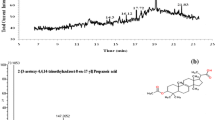Abstract
Pathogen detection needs a paradigm shift from time-consuming conventional microbiological and biochemical tests to much simpler identification methods with higher sensitivity and specificity. In this regard, a simple detection method for frequently isolated nosocomial uropathogen, Proteus spp., was developed using the characteristic volatile 2-methylbutanal released in Luria Bertani broth. The instant reaction of the compound with 5-dimethylaminonaphthalene-1-sulfonylhydrazine (DNSH) has been adapted to develop a sensitive fluorescence assay named “ProteAl” (Prote, “Proteus” & Al, “Aldehyde”). The assay was performed by direct addition of the fluorescence reagent to the culture after 7 h of growth. The distinct green fluorescence by Proteus (other organisms show orange fluorescence) served as the simplest and quicker identification test available for Proteus. In the laboratory, it exhibited 100 % specificity and 100 % sensitivity during testing of 95 strains including standard and known clinical isolates representing frequently encountered uropathogens.






Similar content being viewed by others
References
Abdul GL, Anthony M (2008) Clinical tests: sensitivity and specificity. Contin Educ Anaesth Crit Care Pain 8:221–223
Andre GS, Joshua M, Walter Y, Edmund MP (2002) Rapid detection of pathogenic bacteria by volatile organic compound (VOC) analysis. Proc. SPIE4575
Bungert M, Jahns T, Becker H (2001) 2-Methoxy-3-(1-methylpropyl) pyrazine, pea odour, from the marine bacterium Halomonas venusta. Flavour Fragr J 16:329–333
Christopher C, Carrie AP, Xin L, Harry LTM (2000) Pathogenesis of Proteus mirabilis urinary tract infection. Microb infect 2:1497–1505
David JR (2005) Chemistry and technology of flavour and fragrance. Blackwell, UK
Gerard DW, Arlene DS (2007) New strategies for combating multidrug-resistant bacteria. Trends Mol Med 13:260–267
Guernion N, Ratcliffe NM, Spencer-Phillips PT, Howe RA (2001) Identifying bacteria in human urine: current practice and the potential for rapid, near-patient diagnosis by sensing volatile organic compounds. Clin Chem Lab Med 39:893–906
James RC, Kenneth SS, Keren IH, James AI, Karin RCI, Crystal KI, Jennifer BP, Avijit S, Aaron EW (2011) Rapid Identification of bacteria with a disposable colorimetric sensing array. J Am Chem Soc 133:7571–7576
Jose GR (2009) Statistical intervals: confidence, prediction, enclosure. SAS Institute Inc., USA
Laurent M, Amupuero S, Zesiger TMG, Casey (2004) Screening of aroma-producing lactic acid bacteria with electronic nose. Int Dairy J 14:846–849
Lee H, Robert MLE, Orme PM, Charaklias N, Natasha S, Neus PP, Naresh M, Nicholas S, Catherine AK (2010) Electronic nose analysis of bronchoalveolar lavage fluid. Eur J Clin Invest 41:52–58
Lieuwe DB, Peter JS, Marcus JS (2013) Volatile metabolites of pathogens: a systematic review. PLOS Patho 9
Martin V, Andrea B, Uwe K (2000) Hydrazine reagents as derivatizing agents in environmental analysis—a critical review. Fresenius J Anal Chem 366:781–791
Nicolle LE (2005) Complicated urinary tract infection in adults. Can J Infect Dis Med Microbiol 16:349–360
Norbert B, Holger K, Uwe K, Wilhelm P, Peter AC, Ute W (1998) Analytical reliability of carbonyl compound determination using 1,5-dansylhydrazine-derivatization. Fresenius J Anal Chem 362:270–273
Olinda C, Pinzari F, Fenelli C, Magan N (2004) Application of electronic nose technology for the detection of fungal contamination in library paper. Int Biodeter Biodegr 54:303–309
Samia SK (2012) Urinary tract infection: causative agents, the relation between bacteriuria and pyuria. World Appl Sci J 20:683–686
Sethi S, Nanda R, Chakraborty T (2013) Clinical application of volatile organic compound analysis for detecting infectious diseases. Clin Microbiol Rev 26:462–475
Sheela D, Johanna R (2013) A study on antibiotic susceptibility and resistance profiles of bacterial strains isolated from patients with urinary tract infection (UTI) at Kanchipuram District, Tamilnadu, India. Int J Pharm Pharm Sci 5:817–820
Sichu L (2009) Overview of odor detection instrumentation and the potential for human odor detection in air matrices, Project No. 07MSR216 and 1509532. http://www.mitre.org/work/tech_papers/tech_papers_09/09_4536/09_4536.pdf
Thorn RM, John G (2012) Microbial volatile compounds in health and disease conditions. J Breath Res 6:1–25
Thorn RM, Reynolds DM, Greenman J (2011) Multivariate analysis of bacterial volatile compound profiles for discrimination between selected species and strains in vitro. J Microbiol Meth 84:258–264
Vijayalakshmi V, Arshak K, Korostynska O, Oliwa K, Adley C, Catherine A (2010) An overview of foodborne pathogen detection: In the perspective of biosensors. Biotechnol Adv 28:232–254
William H, Stone K (1958) Reaction of hydrazine with acetic acid at 25 degrees. J Org Chem 23:2032–2034
Zalewska PBM (2011) Urinary tract infections of Escherichia coli strains of chaperone-usher system. Pol J Microbiol 60:279–285
Acknowledgments
We are grateful to Mr. Suresh Lingham, M/s Trivitron Pvt Ltd. for clinical samples, Dr. Sridhar, Dept. of Microbiology, Sri Ramachandra University, for providing standard bacterial cultures; Dr. Mathiyarasu and Sankararao, CECRI, Karaikudi, Dr. T. Sivakumar, Prof. B. Sivasankar, and B. Palanisamy, Anna University, and Prof. Mohanakrishnan, University of Madras, for analysis and analytical data. We acknowledge the financial support from Centre with Potential for Excellence in Environmental Science (CPEES) of University Grants Commission. Our deepest gratitude to our family and friends.
Author disclosure statement
There is no conflict of interests among the authors for submitting this article. This work was supported by the Centre with Potential for Excellence in Environmental Science (CPEES) of University Grants Commission, India. They have no involvements in the study design, in the collection, analysis, and interpretation of data; in the writing of the article; and in the decision to submit the article for publication.
Author information
Authors and Affiliations
Corresponding author
Rights and permissions
About this article
Cite this article
Aarthi, R., Saranya, R. & Sankaran, K. 2-methylbutanal, a volatile biomarker, for non-invasive surveillance of Proteus . Appl Microbiol Biotechnol 98, 445–454 (2014). https://doi.org/10.1007/s00253-013-5393-9
Received:
Revised:
Accepted:
Published:
Issue Date:
DOI: https://doi.org/10.1007/s00253-013-5393-9




